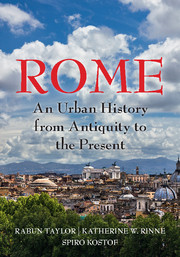Book contents
- Frontmatter
- Dedication
- Epigraph
- Contents
- List of Illustrations
- Acknowledgments
- Map
- INTRODUCTION
- 1 A BEND IN THE RIVER
- 2 A STORYBOOK BEGINNING
- 3 IDEOLOGICAL CROSSFIRE
- 4 BIG MEN ON THE CAMPUS
- 5 RES PUBLICA RESTITUTA
- 6 MEMORIALS IN MOTION: SPECTACLE IN THE CITY
- 7 THE CONCRETE STYLE
- 8 REMAKING ROME'S PUBLIC CORE: I
- 9 REMAKING ROME'S PUBLIC CORE: II
- 10 CRISIS AND CONTINUITY
- 11 RUS IN URBE: A GARDEN CITY
- 12 ADMINISTRATION, INFRASTRUCTURE, AND DISPOSAL OF THE DEAD
- 13 MAPPING, ZONING, AND SEQUESTRATION
- 14 TETRARCHIC AND CONSTANTINIAN ROME
- 15 TROPHIES AND TITULI: CHRISTIAN INFRASTRUCTURE BEFORE CONSTANTINE
- 16 WALLS MAKE CHRISTIANS: FROM FOURTH TO FIFTH CENTURY
- 17 A TALE OF TWO ROMES
- 18 THE ROME OF GOTHS AND BYZANTINES
- 19 CHRISTIAN FOUNDATIONS
- 20 FROM DOMUS LATERANI TO ROMANUM PALATIUM
- 21 THE LEONINE CITY: ST. PETER'S AND THE BORGO
- 22 VIA PAPALIS, THE CHRISTIAN DECUMANUS
- 23 THE URBAN THEATERS OF IMPERIUM AND SPQR
- 24 HOUSING DAILY LIFE
- 25 CHAOS IN THE FORTIFIED CITY
- 26 THE TIBER RIVER
- 27 HUMANIST ROME, ABSOLUTIST ROME (1420–1527)
- 28 PLANNING COUNTER REFORMATION ROME
- 29 PROCESSIONS AND POPULATIONS
- 30 MAGNIFICENT PALACES AND RHETORICAL CHURCHES
- 31 NEOCLASSICAL ROME
- 32 PICTURING ROME
- 33 REVOLUTION AND RISORGIMENTO
- 34 ITALIAN NATIONALISM AND ROMANITÀ
- 35 A CITY TURNED INSIDE OUT
- Glossary of Persons, Places, and Terms
- Works Cited
- Index
25 - CHAOS IN THE FORTIFIED CITY
Published online by Cambridge University Press: 05 July 2016
- Frontmatter
- Dedication
- Epigraph
- Contents
- List of Illustrations
- Acknowledgments
- Map
- INTRODUCTION
- 1 A BEND IN THE RIVER
- 2 A STORYBOOK BEGINNING
- 3 IDEOLOGICAL CROSSFIRE
- 4 BIG MEN ON THE CAMPUS
- 5 RES PUBLICA RESTITUTA
- 6 MEMORIALS IN MOTION: SPECTACLE IN THE CITY
- 7 THE CONCRETE STYLE
- 8 REMAKING ROME'S PUBLIC CORE: I
- 9 REMAKING ROME'S PUBLIC CORE: II
- 10 CRISIS AND CONTINUITY
- 11 RUS IN URBE: A GARDEN CITY
- 12 ADMINISTRATION, INFRASTRUCTURE, AND DISPOSAL OF THE DEAD
- 13 MAPPING, ZONING, AND SEQUESTRATION
- 14 TETRARCHIC AND CONSTANTINIAN ROME
- 15 TROPHIES AND TITULI: CHRISTIAN INFRASTRUCTURE BEFORE CONSTANTINE
- 16 WALLS MAKE CHRISTIANS: FROM FOURTH TO FIFTH CENTURY
- 17 A TALE OF TWO ROMES
- 18 THE ROME OF GOTHS AND BYZANTINES
- 19 CHRISTIAN FOUNDATIONS
- 20 FROM DOMUS LATERANI TO ROMANUM PALATIUM
- 21 THE LEONINE CITY: ST. PETER'S AND THE BORGO
- 22 VIA PAPALIS, THE CHRISTIAN DECUMANUS
- 23 THE URBAN THEATERS OF IMPERIUM AND SPQR
- 24 HOUSING DAILY LIFE
- 25 CHAOS IN THE FORTIFIED CITY
- 26 THE TIBER RIVER
- 27 HUMANIST ROME, ABSOLUTIST ROME (1420–1527)
- 28 PLANNING COUNTER REFORMATION ROME
- 29 PROCESSIONS AND POPULATIONS
- 30 MAGNIFICENT PALACES AND RHETORICAL CHURCHES
- 31 NEOCLASSICAL ROME
- 32 PICTURING ROME
- 33 REVOLUTION AND RISORGIMENTO
- 34 ITALIAN NATIONALISM AND ROMANITÀ
- 35 A CITY TURNED INSIDE OUT
- Glossary of Persons, Places, and Terms
- Works Cited
- Index
Summary
WHEN THE BYZANTINE EMPIRE CEDED CONTROL OVER THE PAPACY IN 752, the Church, now protected by the Franks, became a vassal of the Carolingian dynasty. Charlemagne, first as king (768–814) and then as Holy Roman Emperor (800–814), and Popes Hadrian I and Leo III joined in a relatively stable alliance. Meanwhile, ties between the Church and the Byzantine rulers unraveled in the mid-ninth century as threats from outside invaders such as the Lombards and Saracens increased. The Church and the Holy Roman Empire coexisted uneasily for more than five centuries, with the emperor most often dominating. The growing Roman noble class, itself divided into ruthless factions, sometimes supported the pope and at other times the emperor.
This led to several important changes. The continued Saracen peril on the seas spelled the end of the port facilities at Ostia and Portus, and their abandonment resulted in some new, smaller river ports to augment those already within the city. The exposed countryside contained treasures, both material and spiritual, that had to be moved within the wall for safekeeping or given their own local protection. Relics of martyrs and other Christians, hitherto inviolable where they lay, were now dug up and taken into the city, where they were distributed among the churches. At the same time, the great shrines were fortified. The fort of Johannipolis around the complex of S. Paolo and the Leonine Walls of the Borgo were the work of the ninth century. In the Roman countryside both the castle and the fortified village (both called castellum) had become common. The population shifted markedly to new defensible centers and the domus cultae broke up. The once tightly administered papal domain, a vast landholding operation strapped to the Lateran, splintered into fragments ruled by individual churches, monasteries, and increasingly the rising noble families. The same pattern of breaking up large units into smaller governable – that is, defensible – elements transformed the urban landscape as these families, for protection, engaged their own private gangs for open warfare in the streets.
But by the early tenth century one powerful family – the Tuscolani from ancient Tusculum southeast of Rome – effectively seized Rome and took control of the Church. We first hear of them in the person of Theophylact I (d. 924/5), count of Tusculum.
- Type
- Chapter
- Information
- RomeAn Urban History from Antiquity to the Present, pp. 232 - 240Publisher: Cambridge University PressPrint publication year: 2016



